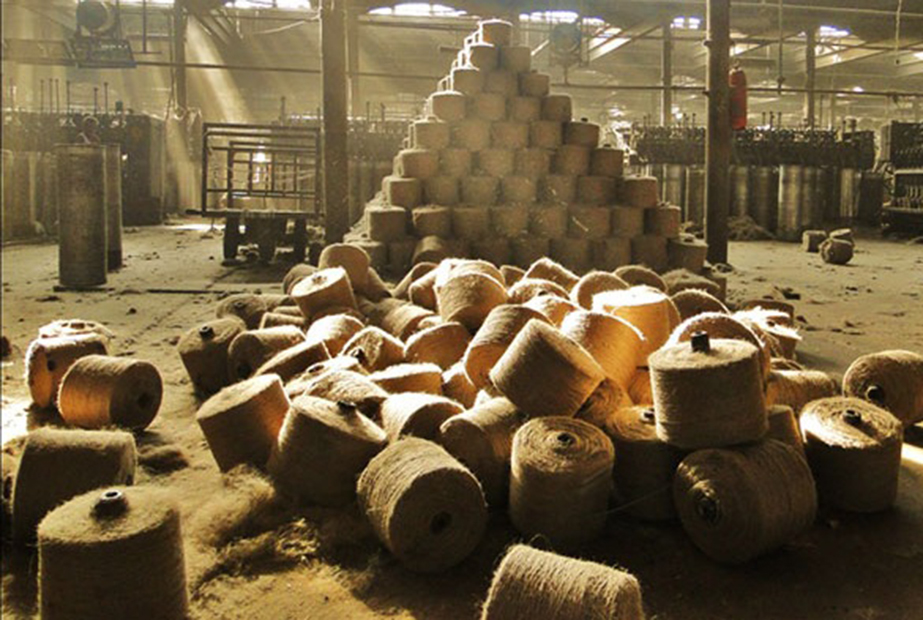The frequent closing down of jute mills have left a lot of workers staring at utter devastation. While some blame the trade unions, others curse the mill administration. G. Singh reports …
Kolkata, 25 September: Guriya has been demanding new clothes from her father ever since she saw her friends going to the market to purchase new dresses for Durga puja. The festive season has arrived, but the six-year old continues to wear the same frock gifted by her father last year.
Her eyes lit up with a sense of expectation when she saw her father pedaling his way back to their dingy shanty. The girl quickly wipes off the dust from her patched frock and eagerly waits for the new clothes which her father had promised to bring. She feels a bit upset on seeing her father returning empty-handed, but she doesn’t lose hope thinking that he may take her to the market to choose her favorite dress.
Mulayam Singh, a jute mill worker at Gloster Limited in Howrah’s Bauria, parks his bicycle in the verandah of the house before asking for a glass of water from his wife.He is lost in deep thought and hardly pays any attention to his daughter.
His haggard countenance suggests that something has gone awry Mulayam had left for work early in the morning as the management had promised to distribute bonus for the festive season. He planned to buy a dress for his daughter, but his plans were shattered after the management declared to give lesser bonus as compared to last year citing economic woes. The move led to resentment among the workers who protested the inhumane decision of the management and decided against taking the reduced amount. Fearing a serious clash, the mill hung suspension of work notice on its gate on September 19. It was deadly blow for labourers like Mulayam who earn a paltry sum of Rs 230 each day.
Mulayam says, “It is a matter of shame for a man who fails to fulfill the needs of his children. My heart would be ripped out by seeing my daughter roaming with the same torn clothes when children of her age would come out with fashionable dresses to go for pandal hopping,” Several thousands of mill labourers across the state have been living a life of poverty and neglect after their mills have been shut down.Since the lynching of the CEO of Northbrook Jute mill in June, this year, eight mills have closed shutters leaving nearly 80,000 workers unemployed. The trade unions cutting across political boundaries and leaders had woken up from their deep slumber post the Northbrook incident and had raised voices in support of the jute mill labourers.
It seemed that something would be done to find a concrete solution for the closing mills. The state government also formed committees to look into the legitimate demands of the workers and how they could be resolved.
The situation has reached the tipping point where the suspension of work served by the mills has become a routine affair. What’s worse, there is no assurance when the closed mills would start operations.
Even if they start, the management might again declare suspension of work. Two mills, Glotis limited and Delta, both in Howrah, suspended work within a span of ten days leaving more than 15,000 workers penniless.
Life is no better for the workers even when the mills are running. The labourers are paid anywhere between Rs 130 and Rs 450 per day depending upon their hierarchy.
A permanent worker is entitled for over Rs 400 each day along with health and post retirement benefits, but a mere 10-15 percent of the workers in jute mills are permanent while others toil as casual workers who get almost half as that of the permanent employees.
Sixty-year-old Md. Hanif who has been working in the mill for last three decades, says that the management is hungry to deduct their wages even for a minor mistake, “They don’t even allow us to talk with our colleagues and humiliate us if we spend more than a few minutes on attending nature’s call. They are always looking out for a chance to cut our wages.” He recalls an instant where his senior insulted him because he had gone to relieve himself more than thrice in four hours, “The manager taunted me that I have turned diabetic and is longer fit to work.”
If it is torturous inside, it is hellish outside: Unhygienic conditions and choked drains are a common sight in almost all the living quarters of the jute mills. Pigs wallow in the mud while the children play in the filth and dust. The stagnant rain water enters the shanties damaging everything from utensils to beds. Workers complain that the mill management stops removing the garbage from near quarters and also snap the power and water supply of the quarters after the suspension of work. Ironically, a certain percentage is deducted as House Rental Allowance (HRA) from their monthly wages every month.
Rahul Prasad, a middle-aged mill employee challenges the scribe to spend a day in their squalid quarters. He says, “We sleep in a bed made wet by the leaking rain water from the tin roof. It often becomes difficult to sleep as the rain water continues to trickle during heavy showers. My children complain about the damped walls, but there is no alternative than to curse our fate silently.” The girl looks malnourished and greets me with a smile on her face. Rahul breaks down on seeing her.
“Our life is virtually destroyed, but our children have no bright future either. They live in the putrid and inhumane conditions without any fault of theirs. It is difficult to make both ends meet leave alone providing them with better education. I don’t know what would happen to them,” he says adding that the frustration has driven him to boozing.
Death is considered as a final relief from the world of pain and suffering. This is, however, not true in the case of these unfortunate labourers for whom death is also a humiliation.
According to an estimate, a whopping Rs 400 crores have been outstanding as gratuities and Provident Funds of the retired workers. Barring a few, majority of the mills doesn’t clear the dues within the mandatory ninety days of retirement. As a result, the gratuities remain unpaid and often the workers die waiting for the post-retirement benefits.
Take for instance, the case of Sonu Singh, a 20-year-old contractual mill labourer whose grandfather Vishwanath Singh died because he could not afford proper medical care. “He was suffering from a respiratory problem and needed an immediate medical attention. The doctors treating him advised us to take him to Delhi, but financial constraints came in the way. Finally, he died last year.” His gratuity was pending with the mill and the repeated requests to clear the sum were left unheard.
According to the claims made by the independent agencies, more than 50,000 jute mill workers of 59 jute mills have been waiting for their gratuities for several years. The mills often state economic issues for not able to clear the dues on time. A question then arises as to what curse has befallen the industry that originated in Bengal. First, we need to know about its history to understand the current situation. The first jute mill of the country was established by George Acland at Rishra, on the river Hooghly near Kolkata in 1855.
He brought jute spinning machinery from Dundee in Scotland and the production started in 1856. The city was selected as it had the ample availability of raw material close by as the jute growing areas were mainly in Bengal.
There was also an abundant supply of labour, ample coal for power, and the city was ideally situated for shipping to world markets. Four years later, the first power driven weaving factory was set up.
Until the middle 1880’s, the jute industry was confined almost to Dundee and Calcutta. France, America, and later Germany, Belgium, Italy, Austria, and Russia, among others, turned to jute manufacturing in the latter part of the 19th century.
By 1869, five mills were operating in Bengal with 950 looms. Their numbers swelled to 38 in 1910 when 30,685 looms exported more than a billion yards of cloth and over 450 million bags. In the following three decades, the jute industry in India enjoyed an even more remarkable expansion, rising to commanding leadership by 1939 with a total of 68,377 looms, concentrated mainly on the River Hooghly near Kolkata.
After Independence, most of the Jute barons started to evacuate India, leaving behind the industrial setup of the Jute Industry. Most of the jute mills were then taken over by the Marwaris businessmen who managed the mills efficiently.
Things, however, began to take a change from the early-nineties when the big industrial houses decided that jute was no longer a profitable affair.
The dwindling demands forced the new owners to look for the profits rather than workers welfare. The industry that relies heavily on government orders, especially Food Corporation of India (FCI) slowly began to face stiff competition from Bangladesh and the plastic industry that has, of late, flooded the domestic market.
The rising costs cropped up as another concern. During recent years, cost of production per ton has gone up substantially affecting not only the profits but also out-pricing the Indian jute goods in International market.
Labour unrest is again a problem as the industry is highly labour-intensive. Another factor responsible is the existence of obsolete machinery in most of the mills that has not been changed for the last several years.
Moreover, wide containerisation and technological developments of plastic and paper material as substitutes for the traditional jute products have adversely affected the position of jute goods in the international market. Bangladesh has taken from the Indian Jute Industry a chunk of the market because of its natural and acquired advantage
Mr Raghvendra Gupta, chairman of the Indian Jute Mills Association concedes that slump in demand and dwindling profits has led to the financial crunch making it difficult for the owners to continue operations.
“The industry has been facing a strong competition from the plastic industry which has led to a drop in demand of jute. We are holding meetings with the government officials to find a permanent solution to the problems faced by the mill owners. A proposal has already been sent to the Union ministry of textiles seeking permission for the construction of new houses for the labourers.”
He adds, that a fear psychosis among the mill owners post the North Brook incident is driving them to suspend work even on minor issues.
The workers blame trade unions for their plight, but unions say they fight for the rights of poor and downtrodden.
“We have always stood by the workers and are fighting for their rights. The mill owners exploit them because they are illiterates,” claims Murari Mohan Sanki, vice-president of Bharatiya Majdur Sangh.
We sincerely pray that the goodness of power and strength brings good luck for the workers so that the dream of Guriya and other children like her gets fulfilled.


